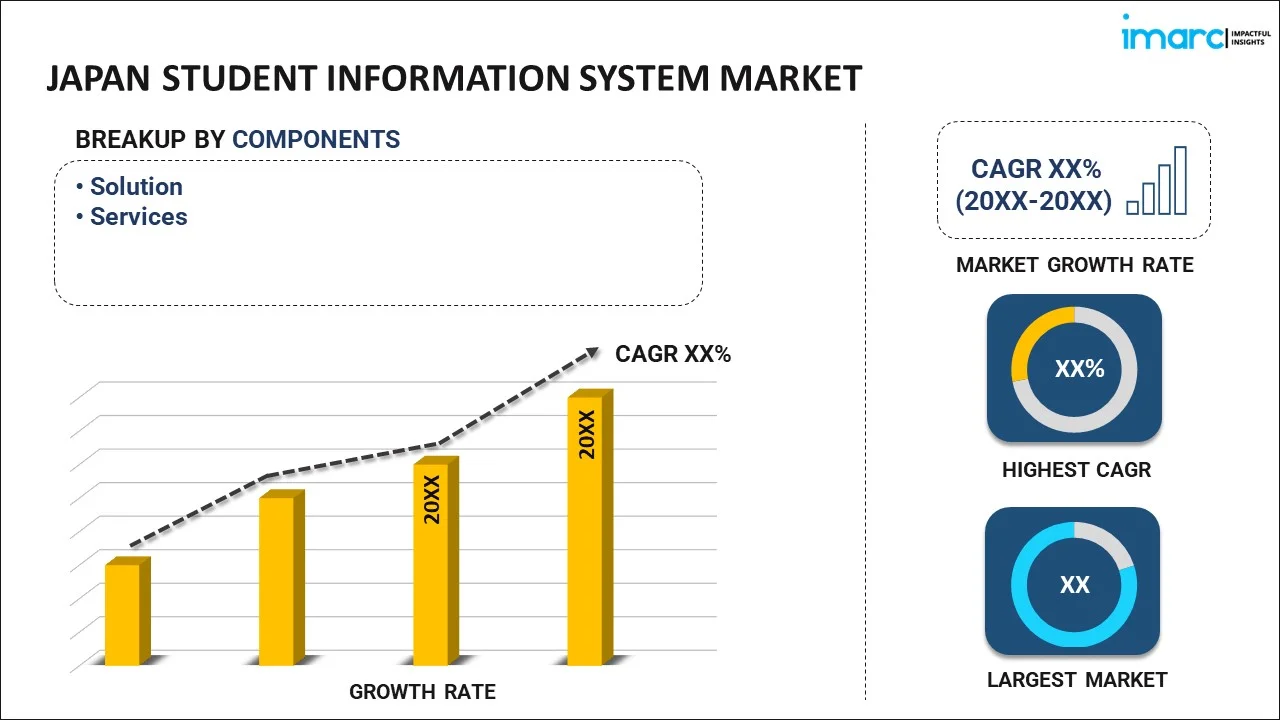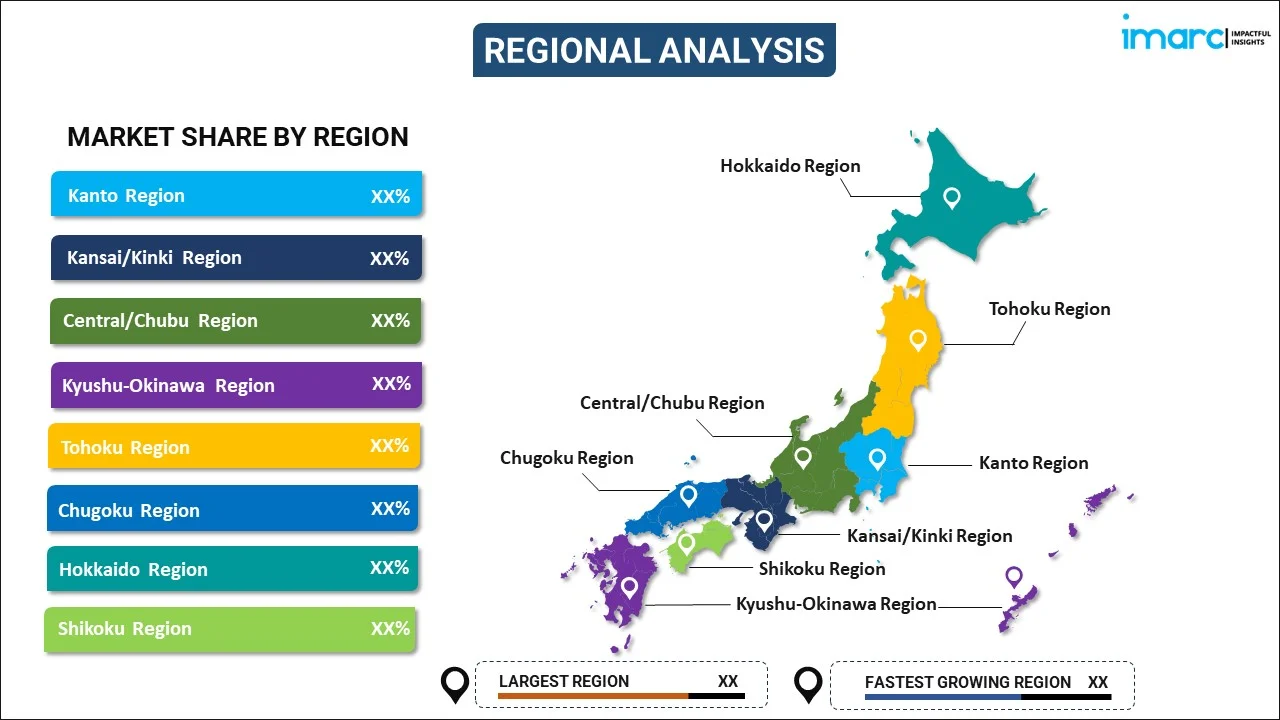
Japan Student Information System Market Report by Component (Solution, Services), Deployment Type (On-premises, Cloud-based), End User (K-12, Higher Education), and Region 2025-2033
Market Overview:
Japan student information system market size reached USD 675.8 Million in 2024. Looking forward, IMARC Group expects the market to reach USD 2,530.4 Million by 2033, exhibiting a growth rate (CAGR) of 14.4% during 2025-2033. The growing adoption of digital learning tools and online education, which has created a need for robust student information system solutions to manage student data, enrollment, and performance tracking in a digital environment, is primarily driving the market.
|
Report Attribute
|
Key Statistics
|
|---|---|
|
Base Year
|
2024
|
|
Forecast Years
|
2025-2033
|
|
Historical Years
|
2019-2024
|
|
Market Size in 2024
|
USD 675.8 Million |
|
Market Forecast in 2033
|
USD 2,530.4 Million |
| Market Growth Rate 2025-2033 | 14.4% |
A student information system (SIS) is a comprehensive software solution designed to manage and organize various aspects of a school or educational institution's administrative processes. It serves as a centralized database to store and retrieve information related to students, faculty, courses, and academic records. Key features of an SIS include student registration and enrollment, grade tracking, attendance monitoring, class scheduling, and communication tools for teachers, students, and parents. It helps streamline administrative tasks, improves data accuracy, and enhances communication among stakeholders. Additionally, an SIS often provides analytical tools for educators to assess student performance and identify areas for improvement. It plays a crucial role in reporting, ensuring compliance with regulatory requirements, and facilitating data-driven decision-making in educational institutions. Overall, an SIS simplifies and automates many administrative functions in the education sector, contributing to more efficient operations and improved student outcomes.
Japan Student Information System Market Trends:
The student information system market in Japan is witnessing robust growth, primarily due to several key drivers that have propelled its adoption across educational institutions. Firstly, the digital transformation of the education sector has been a pivotal factor. With the increasing use of technology in classrooms, institutions are seeking efficient SIS solutions to streamline administrative tasks, enhance data management, and improve overall operational efficiency. Furthermore, the growing emphasis on data-driven decision-making in education has fueled the demand for SIS systems, as they offer valuable insights into student performance and engagement. In addition to this, the inflating need for remote learning solutions has made SIS platforms indispensable for tracking student progress in virtual classrooms. Furthermore, government initiatives aimed at improving education infrastructure and outcomes have encouraged educational institutions to invest in modern SIS solutions. Lastly, the increasing competition among institutions to attract and retain students is expected to drive the regional student information system market, as it enables better communication and engagement with students and parents.
Japan Student Information System Market Segmentation:
IMARC Group provides an analysis of the key trends in each segment of the market, along with forecasts at the country level for 2025-2033. Our report has categorized the market based on component, deployment type, and end user.
Component Insights:

- Solution
- Enrollment
- Academics
- Financial Aid
- Billing
- Services
- Professional Services
- Managed Services
The report has provided a detailed breakup and analysis of the market based on the component. This includes solution (enrollment, academics, financial aid, and billing) and services (professional services and managed services).
Deployment Type Insights:
- On-premises
- Cloud-based
A detailed breakup and analysis of the market based on the deployment type have also been provided in the report. This includes on-premises and cloud-based.
End User Insights:
- K-12
- Higher Education
The report has provided a detailed breakup and analysis of the market based on the end user. This includes K-12 and higher education.
Regional Insights:

- Kanto Region
- Kansai/Kinki Region
- Central/ Chubu Region
- Kyushu-Okinawa Region
- Tohoku Region
- Chugoku Region
- Hokkaido Region
- Shikoku Region
The report has also provided a comprehensive analysis of all the major regional markets, which include Kanto Region, Kansai/Kinki Region, Central/ Chubu Region, Kyushu-Okinawa Region, Tohoku Region, Chugoku Region, Hokkaido Region, and Shikoku Region.
Competitive Landscape:
The market research report has also provided a comprehensive analysis of the competitive landscape. Competitive analysis such as market structure, key player positioning, top winning strategies, competitive dashboard, and company evaluation quadrant has been covered in the report. Also, detailed profiles of all major companies have been provided.
Japan Student Information System Market Report Coverage:
| Report Features | Details |
|---|---|
| Base Year of the Analysis | 2024 |
| Historical Period | 2019-2024 |
| Forecast Period | 2025-2033 |
| Units | Million USD |
| Scope of the Report | Exploration of Historical Trends and Market Outlook, Industry Catalysts and Challenges, Segment-Wise Historical and Future Market Assessment:
|
| Components Covered |
|
| Deployment Types Covered | On-premises, Cloud-based |
| End Users Covered | K-12, Higher Education |
| Regions Covered | Kanto Region, Kansai/Kinki Region, Central/ Chubu Region, Kyushu-Okinawa Region, Tohoku Region, Chugoku Region, Hokkaido Region, Shikoku Region |
| Customization Scope | 10% Free Customization |
| Post-Sale Analyst Support | 10-12 Weeks |
| Delivery Format | PDF and Excel through Email (We can also provide the editable version of the report in PPT/Word format on special request) |
Key Questions Answered in This Report:
- How has the Japan student information system market performed so far and how will it perform in the coming years?
- What has been the impact of COVID-19 on the Japan student information system market?
- What is the breakup of the Japan student information system market on the basis of component?
- What is the breakup of the Japan student information system market on the basis of deployment type?
- What is the breakup of the Japan student information system market on the basis of end user?
- What are the various stages in the value chain of the Japan student information system market?
- What are the key driving factors and challenges in the Japan student information system?
- What is the structure of the Japan student information system market and who are the key players?
- What is the degree of competition in the Japan student information system market?
Key Benefits for Stakeholders:
- IMARC’s industry report offers a comprehensive quantitative analysis of various market segments, historical and current market trends, market forecasts, and dynamics of the Japan student information system market from 2019-2033.
- The research report provides the latest information on the market drivers, challenges, and opportunities in the Japan student information system market.
- Porter's five forces analysis assist stakeholders in assessing the impact of new entrants, competitive rivalry, supplier power, buyer power, and the threat of substitution. It helps stakeholders to analyze the level of competition within the Japan student information system industry and its attractiveness.
- Competitive landscape allows stakeholders to understand their competitive environment and provides an insight into the current positions of key players in the market.
Need more help?
- Speak to our experienced analysts for insights on the current market scenarios.
- Include additional segments and countries to customize the report as per your requirement.
- Gain an unparalleled competitive advantage in your domain by understanding how to utilize the report and positively impacting your operations and revenue.
- For further assistance, please connect with our analysts.
 Inquire Before Buying
Inquire Before Buying
 Speak to an Analyst
Speak to an Analyst
 Request Brochure
Request Brochure
 Request Customization
Request Customization




.webp)




.webp)












